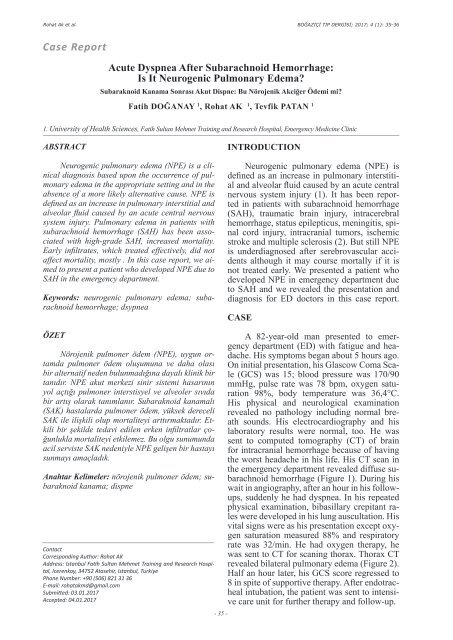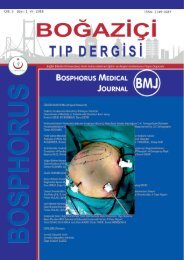Boğaziçi Tıp Dergisi
Boğaziçi Tıp Dergisi Cilt: 4 Sayı: 1 Yıl: 2017
Boğaziçi Tıp Dergisi Cilt: 4 Sayı: 1 Yıl: 2017
Create successful ePaper yourself
Turn your PDF publications into a flip-book with our unique Google optimized e-Paper software.
Rohat Ak et al.<br />
BOĞAZİÇİ TIP DERGİSİ; 2017; 4 (1): 35-36<br />
Case Report<br />
Acute Dyspnea After Subarachnoid Hemorrhage:<br />
Is It Neurogenic Pulmonary Edema?<br />
Subaraknoid Kanama Sonrası Akut Dispne: Bu Nörojenik Akciğer Ödemi mi?<br />
Fatih DOĞANAY 1 , Rohat AK 1 , Tevfik PATAN 1<br />
1. University of Health Sciences, Fatih Sultan Mehmet Training and Research Hospital, Emergency Medicine Clinic<br />
ABSTRACT<br />
Neurogenic pulmonary edema (NPE) is a clinical<br />
diagnosis based upon the occurrence of pulmonary<br />
edema in the appropriate setting and in the<br />
absence of a more likely alternative cause. NPE is<br />
defined as an increase in pulmonary interstitial and<br />
alveolar fluid caused by an acute central nervous<br />
system injury. Pulmonary edema in patients with<br />
subarachnoid hemorrhage (SAH) has been associated<br />
with high-grade SAH, increased mortality.<br />
Early infiltrates, which treated effectively, did not<br />
affect mortality, mostly . In this case report, we aimed<br />
to present a patient who developed NPE due to<br />
SAH in the emergency department.<br />
Keywords: neurogenic pulmonary edema; subarachnoid<br />
hemorrhage; dsypnea<br />
INTRODUCTION<br />
Neurogenic pulmonary edema (NPE) is<br />
defined as an increase in pulmonary interstitial<br />
and alveolar fluid caused by an acute central<br />
nervous system injury (1). It has been reported<br />
in patients with subarachnoid hemorrhage<br />
(SAH), traumatic brain injury, intracerebral<br />
hemorrhage, status epilepticus, meningitis, spinal<br />
cord injury, intracranial tumors, ischemic<br />
stroke and multiple sclerosis (2). But still NPE<br />
is underdiagnosed after serebrovascular accidents<br />
although it may course mortally if it is<br />
not treated early. We presented a patient who<br />
developed NPE in emergency department due<br />
to SAH and we revealed the presentation and<br />
diagnosis for ED doctors in this case report.<br />
CASE<br />
ÖZET<br />
Nörojenik pulmoner ödem (NPE), uygun ortamda<br />
pulmoner ödem oluşumuna ve daha olası<br />
bir alternatif neden bulunmadığına dayalı klinik bir<br />
tanıdır. NPE akut merkezi sinir sistemi hasarının<br />
yol açtığı pulmoner interstisyel ve alveoler sıvıda<br />
bir artış olarak tanımlanır. Subaraknoid kanamalı<br />
(SAK) hastalarda pulmoner ödem, yüksek dereceli<br />
SAK ile ilişkili olup mortaliteyi arttırmaktadır. Etkili<br />
bir şekilde tedavi edilen erken infiltratlar çoğunlukla<br />
mortaliteyi etkilemez. Bu olgu sunumunda<br />
acil serviste SAK nedeniyle NPE gelişen bir hastayı<br />
sunmayı amaçladık.<br />
Anahtar Kelimeler: nörojenik pulmoner ödem; subaraknoid<br />
kanama; dispne<br />
Contact<br />
Corresponding Author: Rohat AK<br />
Address: Istanbul Fatih Sultan Mehmet Training and Research Hospital,<br />
Icerenkoy, 34752 Atasehir, Istanbul, Turkiye<br />
Phone Number: +90 (506) 821 31 36<br />
E-mail: rohatakmd@gmail.com<br />
Submitted: 03.01.2017<br />
Accepted: 04.01.2017<br />
- 35 -<br />
A 82-year-old man presented to emergency<br />
department (ED) with fatigue and headache.<br />
His symptoms began about 5 hours ago.<br />
On initial presentation, his Glascow Coma Scale<br />
(GCS) was 15; blood pressure was 170/90<br />
mmHg, pulse rate was 78 bpm, oxygen saturation<br />
98%, body temperature was 36,4°C.<br />
His physical and neurological examination<br />
revealed no pathology including normal breath<br />
sounds. His electrocardiography and his<br />
laboratory results were normal, too. He was<br />
sent to computed tomography (CT) of brain<br />
for intracranial hemorrhage because of having<br />
the worst headache in his life. His CT scan in<br />
the emergency department revealed diffuse subarachnoid<br />
hemorrhage (Figure 1). During his<br />
wait in angiography, after an hour in his followups,<br />
suddenly he had dyspnea. In his repeated<br />
physical examination, bibasillary crepitant rales<br />
were developed in his lung auscultation. His<br />
vital signs were as his presentation except oxygen<br />
saturation measured 88% and respiratory<br />
rate was 32/min. He had oxygen therapy, he<br />
was sent to CT for scaning thorax. Thorax CT<br />
revealed bilateral pulmonary edema (Figure 2).<br />
Half an hour later, his GCS score regressed to<br />
8 in spite of supportive therapy. After endotracheal<br />
intubation, the patient was sent to intensive<br />
care unit for further therapy and follow-up.



